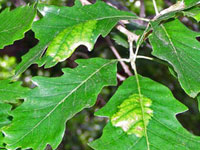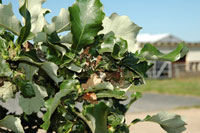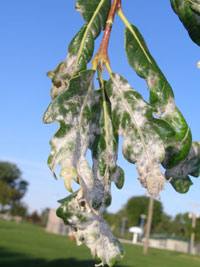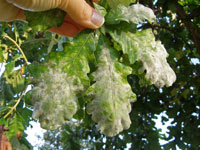Extension > Garden > Diagnose a problem > What's wrong with my plant? > Deciduous Trees > Oak > Leaves are curled, cupped or deformed
Oak > Leaves > Leaves are curled, cupped or deformed
1 of 4
Oak anthracnose
Discula quercina
- Affected leaves become wrinkled, cupped or curled especially around leaf edges
- Leaves have scattered brown, irregular spots that can coalesce into nearly completely brown leaves
- On severely infected trees, leaves fall off early in the season, trees soon sends out new leaves
- Damage is most common on lower and interior branches
- Damage most common in spring as leaves are growing during wet weather
- Most affected are trees within white oak group (white oak, bur oak, swamp white oak)
- More information on Oak anthracnose
2 of 4
Oak leaf blister
Taphrina caerulescens
- Heavy infestation will cause leaf to curl after the blisters have merged together
- Raised blister-like leaf spots; appear sunken from the underside of the leaf
- Leaf blisters are initially pale green to orange, but turn brown with age
- Blister areas range from 1/16 to 1/2 inch in length
- Leaves do not drop
- Damage most common in spring as leaves are growing during wet weather
- More information on Oak leaf blister
3 of 4
Noxious oak gall
Neuroterus noxiosus
- Leaves become dwarfed, curled or shriveled
- Tuber-like, irregular or potato-shaped growth that is ¼ to 4 inches long on branches
- Associated with swamp white oak
4 of 4
Powdery mildew
Phyllactinia guttata
- Severely infected leaves are often curled or distorted
- White or gray powdery mats resembling talcum powder occur in spots, blotches or coat leaves
- Lower shaded leaves are most commonly affected, common on small understory trees
- Damage is common in spring or fall
- More information on Powdery mildew















